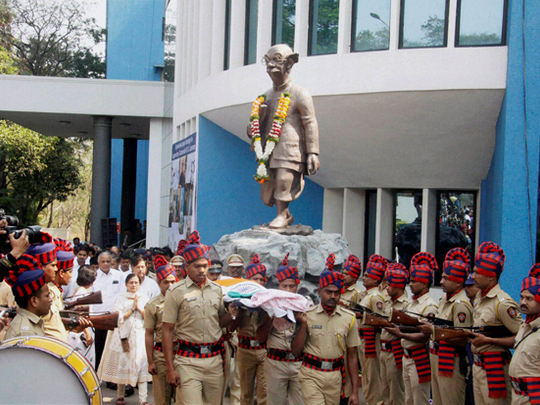
Mumbai: R.K. Laxman, India’s endearing and eminent cartoonist, illustrator and humorist, who died at the age of 94 on Monday, at a private hospital in Pune after suffering multi-organ failure, was on Tuesday given a state funeral by the Maharashtra government.
He had been on life support for several days at the Dinanath Mangeshkar Hospital in Pune.
He was given full state honours at the Vaikuntha Crematorium, where the last funeral rites were performed. Laxman is survived by his wife Kamala, son and retired journalist Srinvas, daughter-in-law Usha and grand daughter Rimanika.
While paying homage to the cartoonist, Chief Minister Devendra Fadnavis announced a memorial for the legendary cartoonist and said: “Laxman was not just a cartoonist — what he said through his cartoons will inspire future governments. Though he is no more, The Common Man he created will live forever.” Besides Fadnavis and his cabinet colleagues, top political leaders including Shiv Sena chief Uddhav Thackeray, Maharashtra Navnirman Sena chief Raj Thackeray and several people from all walks of life came to a private college in Pune to pay their respects.
Laxman’s common man was a small bespectacled man with a bushy moustache, tufts of hair on the rim of a balding head, wearing a checked coat with patch work — who became a symbol of what the ordinary people endured under various governments and politicians. He also exposed the doublespeak of politicians though subtle humour.
Though he stopped drawing cartoons years ago, his works and steady jibes at politicians remain alive and apt even in the present-day political scenario. Whether his cartoons related to price rise, looting, corruption, riots, bad roads or poverty, they remain pertinent in the India of today. However, he once complained of politicians as “they all look the same today” unlike in the past.
Born in Mysore, Karnataka, on October 24 1921, Rasipuram Krishnaswamy Laxman was the youngest of six sons who roamed freely in the rustic surroundings of Mysore taking in the beauty of nature. As a child he was drawing on his own, on the floors, walls, doors of his house and doodling caricatures of his teachers at school. H
e says in his book, The Tunnel of Time, “I do not remember wanting to do anything else except draw … I do not remember a day when I have not sketched, whether it was time to prepare for examinations or lying in bed recovering from a fever.”
His big moment came in school when the pupils were asked to draw a leaf, which he did easily and earned praise from his teacher.
After high school, Laxman applied to the JJ School of Art, Bombay hoping to concentrate on drawing and painting but the dean of the school wrote to him that his drawing lacked “talent.” So he finally graduated with a Bachelor of Arts from the University of Mysore and continued to freelance, contributing to Swarajya. His full time job as a cartoonist was in Free Press Journal in Mumbai and later he joined The Times of India.
A brother of illustrious novelist R.K. Narayan, for whom he also did sketches for his fictional Malgudi stories, Laxman has been an inspiration to all Indian cartoonists.
His inimitable style and humour earned him several awards during his lifetime — including Padma Bhushan and Padma Vibhushan from the Government of India in 1971 and 2005 respectively and the Ramon Magsaysay Award for Journalism in 2008. A statue of “The Common Man” has been erected at Symbiosis Institute, Pune, where he lived until his death.












